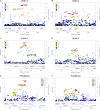Promising therapeutic targets for ischemic stroke identified from plasma and cerebrospinal fluid proteomes: a multicenter Mendelian randomization study
- PMID: 38016292
- PMCID: PMC10871597
- DOI: 10.1097/JS9.0000000000000922
Promising therapeutic targets for ischemic stroke identified from plasma and cerebrospinal fluid proteomes: a multicenter Mendelian randomization study
Abstract
Background: Ischemic stroke (IS) is more common every year, the condition is serious, and have a poor prognosis. New, efficient, and safe therapeutic targets are desperately needed as early treatment especially prevention and reperfusion is the key to lowering the occurrence of poorer prognosis. Generally circulating proteins are attractive therapeutic targets, this study aims to identify potential pharmacological targets among plasma and cerebrospinal fluid (CSF) proteins for the prevention and treatment of IS using a multicenter Mendelian randomization (MR) approach.
Methods: First, the genetic instruments of 734 plasma and 151 CSF proteins were assessed for causative connections with IS from MEGASTROKE consortium by MR to identify prospective therapeutic targets. Then, for additional validation, plasma proteins from the deCODE consortium and the Fenland consortium, as well as IS GWAS data from the FinnGen cohort, the ISGC consortium and UK biobank, were employed. A thorough evaluation of the aforementioned possible pharmacological targets was carried out using meta-analysis. The robustness of MR results was then confirmed through sensitivity analysis using several techniques, such as bidirectional MR analysis, Steiger filtering, and Bayesian colocalization. Finally, methods like Protein-Protein Interaction (PPI) Networking were utilized to investigate the relationship between putative drug targets and therapeutic agents.
Results: The authors discovered three proteins that may function as promising therapeutic targets for IS and meet the Bonferroni correction ( P <0.05/885=5.65×10 -5 ). Prekallikrein (OR=0.41, 95% CI: 0.27-0.63, P =3.61×10 -5 ), a protein found in CSF, has a 10-fold protective impact in IS, while the plasma proteins SWAP70 (OR=0.85, 95% CI: 0.80-0.91, P =1.64×10 -6 ) and MMP-12 (OR=0.92, 95% CI: 0.89-0.95, P =4.49×10 -6 ) of each SD play a protective role in IS. Prekallikrein, MMP-12, SWAP70 was replicated in the FinnGen cohort and ISGC database. MMP-12 (OR=0.93, 95% CI: 0.91-0.94, P <0.001), SWAP70 (OR=0.92, 95% CI: 0.90-0.94, P <0.001), and prekallikrein (OR=0.53, 95% CI: 0.33-0.72, P <0.001) may all be viable targets for IS, according to the combined meta-analysis results. Additionally, no evidence of reverse causality was identified, and Bayesian colocalization revealed MMP-12 (PPH 4 =0.995), SWAP70 (PPH 4 =0.987), and prekallikrein (PPH 4 =0.894) shared the same variant with IS, supporting the robustness of the aforementioned causation. Prekallikrein and MMP-12 were associated with the target protein of the current treatment of IS. Among them, Lanadelumab, a new drug whose target protein is a prekallikrein, may be a promising new drug for the treatment of IS.
Conclusion: The prekallikrein, MMP-12, and SWAP70 are causally associated with the risk of IS. Moreover, MMP-12 and prekallikrein may be treated as promising therapeutic targets for medical intervention of IS.
Copyright © 2024 The Author(s). Published by Wolters Kluwer Health, Inc.
Conflict of interest statement
The authors declare that the research was conducted in the absence of any commercial or financial relationships that could be construed as a potential conflict of interest.
Sponsorships or competing interests that may be relevant to content are disclosed at the end of this article.
Figures









References
-
- Tao T, Liu M, Chen M, et al. . Natural medicine in neuroprotection for ischemic stroke: challenges and prospective. Pharmacol Ther 2020;216:107695. - PubMed
Publication types
MeSH terms
Substances
LinkOut - more resources
Full Text Sources
Medical
Miscellaneous

